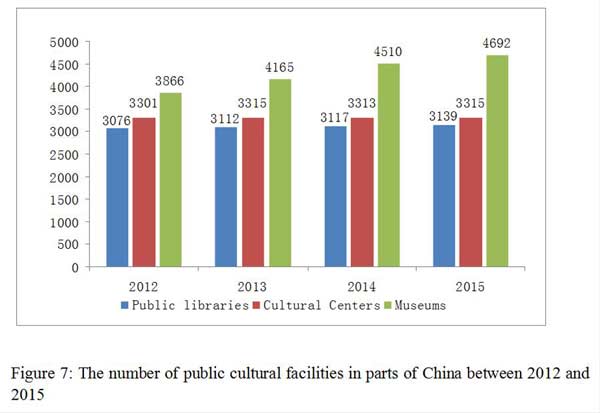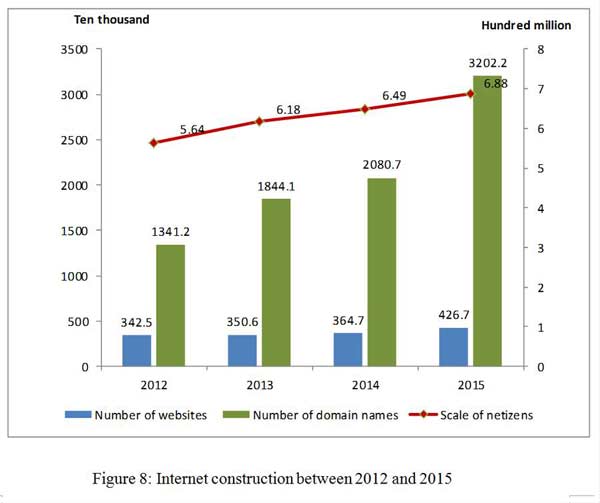Full coverage: China 2012-2015 Human Rights Progress Review
(6) Cultural rights
Figure 7: The number of public cultural facilities in parts of China between 2012 and 2015
[GRAPHICS]CHINA-2012-2015-NATIONAL HUMAN RIGHTS ACTION PLAN(CN)

BEIJING, June 14, 2016 (Xinhua) -- Graphics shows the number of public cultural facilities in parts of China between 2012 and 2015 in the Assessment Report on the Implementation of the National Human Rights Action Plan of China (2012-2015). (Xinhua)
Public cultural facilities have been further improved. By the end of 2015, China had built 3,139 public libraries, 3,315 cultural centers, 40,976 cultural stations, 4,692 museums and 409 science and technology museums. Between 2012 and 2015, the central government invested 20.3 billion yuan cumulatively to support the free admission to public cultural facilities. By the end of 2015, the number of museums open to the public free of charge had reached 4,013. The central government has invested 9.223 billion yuan to make sure that radio and TV broadcasts basically cover all villages with no more than 20 households each and where electricity is available. As part of a cultural information resource sharing project, China has built 35,500 service centers and sub-centers in cities and townships and service stations at the grassroots level covering 700,000 villages and communities, which are able to share digital resources amounting to 532 TB, surpassing the planned goal. China has established 600,449 farmers' libraries, and sent more than 1 billion books and periodicals to rural areas. The country has also built 24,000 satellite digital farmers' libraries and 252 rural digital movie lines, and organized more than 50,000 movie projection teams. Satellite digital movies basically covered 640,000 administrative villages with over 9 million movie screenings purchased annually.
Figure 8: Internet construction between 2012 and 2015
[GRAPHICS]CHINA-2012-2015-NATIONAL HUMAN RIGHTS ACTION PLAN(CN)

BEIJING, June 14, 2016 (Xinhua) -- Graphics shows internet construction between 2012 and 2015 in the Assessment Report on the Implementation of the National Human Rights Action Plan of China (2012-2015). (Xinhua)
Internet construction has provided more convenient conditions for citizens to enjoy cultural rights. At the end of 2015, 688 million people had access to the Internet, covering 50.3 percent of China's population, surpassing the planned goal of 45 percent. The fixed broadband users and households reached 210 million. The internet broadband ports reached 470 million, exceeding the planned goal of 370 million. Fiber optic Internet connection covered 446 million households, surpassing the planned goal by more than 100 percent.
(7) Environmental rights
China has amended the Law on Environmental Protection, with special provisions on information transparency and public participation to guarantee the public's right to be informed, participate and supervise and provisions for improving the public interest litigation system to provide related social groups with the right to launch public interest litigations and strengthen the system of accountability.
Heavy metal pollution has effectively been brought under control. Between 2010 and 2015, the central government appropriated 17.2 billion yuan to support control over heavy metal pollution. In 2014, the total pollutant discharge of 5 major heavy metals including lead, mercury, cadmium, chromium and the metalloid element - arsenic, decreased by 20 percent as compared with that in 2007. The number of heavy metal pollution incidents decreased from more than 10 annually on average between 2010 and 2011 to an annual average of less than 3 between 2012 and 2015.
The capability for water pollution treatment has increased. In April 2015, the State Council announced "action plan for water pollution prevention and control". The percentage of inferior class V surface water decreased from 35.7 percent in 2001 to 8.8 percent in 2015. During the 2011-2015 period, sewage treatment capacity increased by an additional 48 million tons per day. In 2015, 97.1 percent of the drinking water from centralized supply sources in 338 cities at the prefecture level and above met the quality standard.
Efforts for air quality control have been boosted. In August 2015, China amended the law on air pollution prevention and control, made improving atmospheric quality as its goal, emphasized government responsibilities and improved measures targeted towards controlling air pollution. Between 2011 and 2015, the emissions of 4 major pollutants including chemical oxygen demand, ammonia nitrogen, sulfur dioxide and nitric oxide decreased 12.9 percent, 13.0 percent, 18.0 percent and 18.6 percent respectively. In September 2013, the State Council distributed the Action Plan on Air Pollution Prevention and Control, in which it clarified comprehensive treatment measures composed of 10 articles and 35 items, focusing on fine particulate matter (PM2.5) and inhalable particles (PM10). In 2015, all cities at the prefecture level and above adopted new environmental and air quality standards. China built the largest air quality monitoring network among all developing countries with 338 cities at the prefecture level and above across the country having the capability of monitoring 6 indices including PM2.5. Efforts were made to strengthen the standardization of energy conservation and low carbon. During the 2011-2015 period, the government implemented a project involving the formation and improvement of 100 important energy-saving standards and approved the release of 205 energy-saving state criteria. In 2015, the General Office of the State Council issued the guidelines on strengthening the standardization of energy conservation. The government approved the emissions standards for 10 industries that produce greenhouse gases including steel, iron and cement and issued the phase 5 national standards for automobile fuel.
Ecosystem construction has been further pushed forward. With the establishment of the State Committee on Biodiversity Protection, the Ministry of Environmental Protection issued China's Biodiversity Conservation Strategy and Action Plan (2011-2030), and started China's Action for United Nations Decade on Biodiversity. Between 2011 and 2015, China invested 89.8 billion yuan in projects for the conservation of natural forest resources, and put 1.08 million square kilometers of natural forests under effective protection. Efforts were made to continually push forward the construction of key forest shelterbelts in northeast, north and northwest China, the control over the sources of sandstorms affecting Beijing and Tianjin, the comprehensive treatment of stony desertification in karst areas, the key ecological projects of pastureland rehabilitation and the launch of a new round of projects to return farmland back to forestry and pastureland. Between 2011 and 2015, China had already built a localized biodiversity protection network with nature reserves acting as the backbone. The area of established nature reserves reached 1.47 million square kilometers, accounting for 14.84 percent of the country's total land area. Over 90 percent of the country' s land ecosystems, 89 percent of wildlife species under state protection and 86 percent of wild plant species under state protection were conserved in nature reserves. By the end of 2015, China's forest coverage reached 21.66 percent. More than 260,000 square kilometers of land suffering from soil erosion had been treated, which was more than the projected figure. By the end of 2014, the national greenery coverage in urban areas was 40.22 percent, surpassing the planned goal ahead of schedule.
Efforts were made to continually strengthen the enforcement of environmental laws and an accountability system. To implement and put into effect the newly amended Law on Environmental Protection and a circular issued by the General Office of the State Council on strengthening environmental protection supervision, environment monitoring bodies across the country actively innovated with new methods and modes of supervision and law enforcement, and successively carried out targeted actions and inspections on environmental protection and cracked down severely on environmental law violations and environmental pollution crimes, and effectively safeguarded the environmental rights of the public. A compensation system for the damage to the ecosystem has been further improved.















